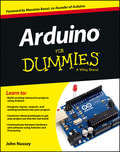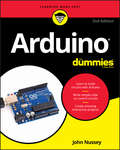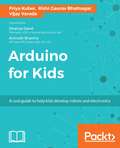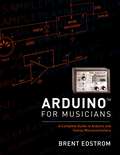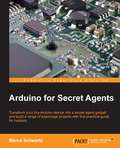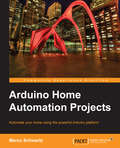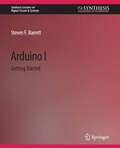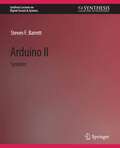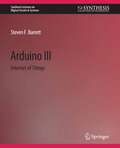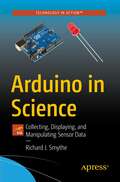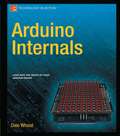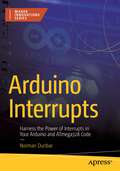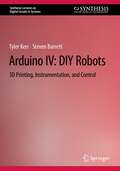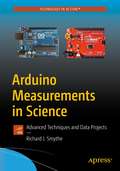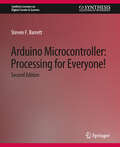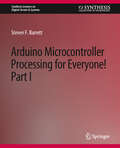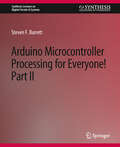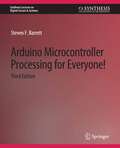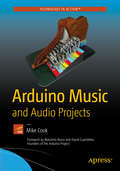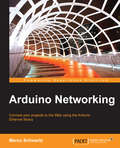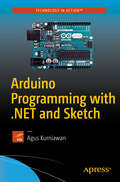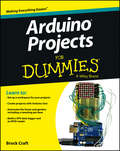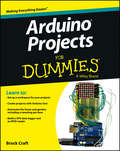- Table View
- List View
Arduino For Dummies
by John NusseyThe quick, easy way to leap into the fascinating world of physical computing This is no ordinary circuit board. Arduino allows anyone, whether you're an artist, designer, programmer or hobbyist, to learn about and play with electronics. Through this book you learn how to build a variety of circuits that can sense or control things in the real world. Maybe you'll prototype your own product or create a piece of interactive artwork? This book equips you with everything you'll need to build your own Arduino project, but what you make is up to you! If you're ready to bring your ideas into the real world or are curious about the possibilities, this book is for you. ? Learn by doing ? start building circuits and programming your Arduino with a few easy to follow examples - right away! ? Easy does it ? work through Arduino sketches line by line in plain English, to learn of how a they work and how to write your own ? Solder on! ? Only ever used a breadboard in the kitchen? Don't know your soldering iron from a curling iron? No problem, you'll be prototyping in no time ? Kitted out ? discover new and interesting hardware to make your Arduino into anything from a mobile phone to a geiger counter! ? Become an Arduino savant ? learn all about functions, arrays, libraries, shields and other tools of the trade to take your Arduino project to the next level. ? Get social ? teach your Arduino to communicate with software running on a computer to link the physical world with the virtual world It's hardware, it's software, it's fun! Start building the next cool gizmo with Arduino and Arduino For Dummies.
Arduino For Dummies
by John NusseyBring your ideas to life with the latest Arduino hardware and software Arduino is an affordable and readily available hardware development platform based around an open source, programmable circuit board. You can combine this programmable chip with a variety of sensors and actuators to sense your environment around you and control lights, motors, and sound. This flexible and easy-to-use combination of hardware and software can be used to create interactive robots, product prototypes and electronic artwork, whether you’re an artist, designer or tinkerer. Arduino For Dummies is a great place to start if you want to find out about Arduino and make the most of its incredible capabilities. It helps you become familiar with Arduino and what it involves, and offers inspiration for completing new and exciting projects. • Covers the latest software and hardware currently on the market • Includes updated examples and circuit board diagrams in addition to new resource chapters • Offers simple examples to teach fundamentals needed to move onto more advanced topics • Helps you grasp what’s possible with this fantastic little board Whether you’re a teacher, student, programmer, hobbyist, hacker, engineer, designer, or scientist, get ready to learn the latest this new technology has to offer!
Arduino for Kids
by Priya Kuber Rishi Gaurav Bhatnagar Vijay VaradaA cool guide to help kids develop robots and electronics About This Book • Get clearly-written code with descriptions and comments that explain each code section • The book comes with separate code files, one entire program at a time, as well as many diagrams and separate downloadable files that contain colored photos explaining steps in the book • Kids can build multiple projects during the course of the book; by the end, they will have working projects of their own Who This Book Is For This book is for children aged 9 and up, and their parents, who may or may not have a technical background. This book is tailored around the central idea of introducing electronics as a fun and a curiosity-inducing exercise. This book can act as a bonding exercise between parent and child over a single weekend. What You Will Learn • Write simple programs using variables, functions, loops, arrays, and libraries • Set up the Arduino and understand its internal functioning • Get to grips with connections in electronics and arrive at ways to connect various components yourself • Delve into various sensors and their selection and build your own sensor • Unravel the concept of resistors and capacitors along with understanding the physics of electronics • Become an inventor through interactive exercises (such as making a friend happy with a proximity sensor, and giving "life" to a plant) In Detail The mission of this book is to integrate technology with the tools that children already use for crafts so that they feel that the technology is an extension of their playtime. We use coding, sensors, and micro-controllers integrated with art and craft supplies, origami, and Playdough. There are 10 fun-filled chapters that talk to children directly, and give clear instructions for non-technical parents too. We use Arduino as the controller of choice due to its easy availability and large community. By the end of the book, children will comfortably be able to set up their Arduino, read and understand code, manipulate code, and ultimately write their own code for projects. They will also be able to use basic sensors and know how components connect to each other. All the learning takes place with lots of colorful pictures and the circuits are neatly presented using wiring. Style and approach This book will show you the glamour of common and easily available sensors, so that kids and parents waste no time searching for parts. We provide simple yet fun projects with step-by-step instructions that make it easy to get hands-on.
Arduino for Musicians: A Complete Guide to Arduino and Teensy Microcontrollers
by Brent EdstromArduino, Teensy, and related microcontrollers provide a virtually limitless range of creative opportunities for musicians and hobbyists who are interested in exploring "do it yourself" technologies. Given the relative ease of use and low cost of the Arduino platform, electronic musicians can now envision new ways of synthesizing sounds and interacting with music-making software. In Arduino for Musicians, author and veteran music instructor Brent Edstrom opens the door to exciting and expressive instruments and control systems that respond to light, touch, pressure, breath, and other forms of real-time control. He provides a comprehensive guide to the underlying technologies enabling electronic musicians and technologists to tap into the vast creative potential of the platform. Arduino for Musicians presents relevant concepts, including basic circuitry and programming, in a building-block format that is accessible to musicians and other individuals who enjoy using music technology. In addition to comprehensive coverage of music-related concepts including direct digital synthesis, audio input and output, and the Music Instrument Digital Interface (MIDI), the book concludes with four projects that build on the concepts presented throughout the book. The projects, which will be of interest to many electronic musicians, include a MIDI breath controller with pitch and modulation joystick, "retro" step sequencer, custom digital/analog synthesizer, and an expressive MIDI hand drum. Throughout Arduino for Musicians, Edstrom emphasizes the convenience and accessibility of the equipment as well as the extensive variety of instruments it can inspire. While circuit design and programming are in themselves formidable topics, Edstrom introduces their core concepts in a practical and straightforward manner that any reader with a background or interest in electronic music can utilize. Musicians and hobbyists at many levels, from those interested in creating new electronic music devices, to those with experience in synthesis or processing software, will welcome Arduino for Musicians.
ARDUINO FOR MUSICIANS C: A Complete Guide to Arduino and Teensy Microcontrollers
by Brent EdstromArduino, Teensy, and related microcontrollers provide a virtually limitless range of creative opportunities for musicians and hobbyists who are interested in exploring "do it yourself" technologies. Given the relative ease of use and low cost of the Arduino platform, electronic musicians can now envision new ways of synthesizing sounds and interacting with music-making software. In Arduino for Musicians, author and veteran music instructor Brent Edstrom opens the door to exciting and expressive instruments and control systems that respond to light, touch, pressure, breath, and other forms of real-time control. He provides a comprehensive guide to the underlying technologies enabling electronic musicians and technologists to tap into the vast creative potential of the platform. Arduino for Musicians presents relevant concepts, including basic circuitry and programming, in a building-block format that is accessible to musicians and other individuals who enjoy using music technology. In addition to comprehensive coverage of music-related concepts including direct digital synthesis, audio input and output, and the Music Instrument Digital Interface (MIDI), the book concludes with four projects that build on the concepts presented throughout the book. The projects, which will be of interest to many electronic musicians, include a MIDI breath controller with pitch and modulation joystick, "retro" step sequencer, custom digital/analog synthesizer, and an expressive MIDI hand drum. Throughout Arduino for Musicians, Edstrom emphasizes the convenience and accessibility of the equipment as well as the extensive variety of instruments it can inspire. While circuit design and programming are in themselves formidable topics, Edstrom introduces their core concepts in a practical and straightforward manner that any reader with a background or interest in electronic music can utilize. Musicians and hobbyists at many levels, from those interested in creating new electronic music devices, to those with experience in synthesis or processing software, will welcome Arduino for Musicians.
Arduino for Secret Agents
by Marco SchwartzTransform your tiny Arduino device into a secret agent gadget to build a range of espionage projects with this practical guide for hackers About This Book • Discover the limitless possibilities of the tiny Arduino and build your own secret agent projects • From a fingerprint sensor to a GPS Tracker and even a robot– learn how to get more from your Arduino • Build nine secret agent projects using the power and simplicity of the Arduino platform Who This Book Is For This book is for Arduino programmers with intermediate experience of developing projects, and who want to extend their knowledge by building projects for secret agents. It would also be great for other programmers who are interested in learning about electronics and programming on the Arduino platform. What You Will Learn • Get to know the full range of Arduino features so you can be creative through practical projects • Discover how to create a simple alarm system and a fingerprint sensor • Find out how to transform your Arduino into a GPS tracker • Use the Arduino to monitor top secret data • Build a complete spy robot! • Build a set of other spy projects such as Cloud Camera and Microphone System In Detail Q might have Bond's gadgets– but he doesn't have an Arduino (not yet at least). Find out how the tiny Arduino microcomputer can be used to build an impressive range of neat secret agent projects that can help you go undercover and get to grips with the cutting-edge of the world of espionage with this book, created for ardent Arduino fans and anyone new to the powerful device. Each chapter shows you how to construct a different secret agent gadget, helping you to unlock the full potential of your Arduino and make sure you have a solution for every tricky spying situation. You'll find out how to build everything from an alarm system to a fingerprint sensor, each project demonstrating a new feature of Arduino, so you can build your expertise as you complete each project. Learn how to open a lock with a text message, monitor top secret data remotely, and even create your own Arduino Spy Robot, Spy Microphone System, and Cloud Spy Camera This book isn't simply an instruction manual – it helps you put your knowledge into action so you can build every single project to completion. Style and approach This practical reference guide shows you how to build various projects with step-by-step explanations on each project, starting with the assembly of the hardware, followed by basics tests of all those hardware components and finally developing project on the hardware.
Arduino Home Automation Projects
by Marco SchwartzThis book is divided into projects that are explained in a step-by-step format, with practical instructions that are easy to follow. If you want to build your own home automation systems wirelessly using the Arduino platform, this is the book for you. You will need to have some basic experience in Arduino and general programming languages, such as C and C++ to understand the projects in this book.
Arduino I: Getting Started (Synthesis Lectures on Digital Circuits & Systems)
by Steven F. BarrettThis book is about the Arduino microcontroller and the Arduino concept. The visionary Arduino team of Massimo Banzi, David Cuartielles, Tom Igoe, Gianluca Martino, and David Mellis launched a new innovation in microcontroller hardware in 2005, the concept of open-source hardware. Their approach was to openly share details of microcontroller-based hardware design platforms to stimulate the sharing of ideas and promote innovation. This concept has been popular in the software world for many years. In June 2019, Joel Claypool and I met to plan the fourth edition of Arduino Microcontroller Processing for Everyone! Our goal has been to provide an accessible book on the rapidly changing world of Arduino for a wide variety of audiences including students of the fine arts, middle and senior high school students, engineering design students, and practicing scientists and engineers. To make the book more accessible to better serve our readers, we decided to change our approach and provide a series of smaller volumes. Each volume is written to a specific audience. This book, Arduino I: Getting Started is written for those looking for a quick tutorial on the Arduino environment, platforms, interface techniques, and applications. Arduino II will explore advanced techniques, applications, and systems design. Arduino III will explore Arduino applications in the Internet of Things (IoT). Arduino I: Getting Started covers three different Arduino products: the Arduino UNO R3 equipped with the Microchip ATmega328, the Arduino Mega 2560 equipped with the Microchip ATmega2560, and the wearable Arduino LilyPad.
Arduino II: Systems (Synthesis Lectures on Digital Circuits & Systems)
by Steven F. BarrettThis book is about the Arduino microcontroller and the Arduino concept. The visionary Arduino team of Massimo Banzi, David Cuartielles, Tom Igoe, Gianluca Martino, and David Mellis launched a new innovation in microcontroller hardware in 2005, the concept of open-source hardware. Their approach was to openly share details of microcontroller-based hardware design platforms to stimulate the sharing of ideas and promote innovation. This concept has been popular in the software world for many years. In June 2019, Joel Claypool and I met to plan the fourth edition of Arduino Microcontroller Processing for Everyone! Our goal has been to provide an accessible book on the rapidly evolving world of Arduino for a wide variety of audiences including students of the fine arts, middle and senior high school students, engineering design students, and practicing scientists and engineers. To make the book even more accessible to better serve our readers, we decided to change our approach and provide a series of smaller volumes. Each volume is written to a specific audience. This book, Arduino II: Systems, is a detailed treatment of the ATmega328 processor and an introduction to C programming and microcontroller-based systems design. Arduino I: Getting Started provides an introduction to the Arduino concept. Arduino III: the Internet of Things explores Arduino applications in the Internet of Things (IoT).
Arduino III: Internet of Things (Synthesis Lectures on Digital Circuits & Systems)
by Steven F. BarrettThis book is about the Arduino microcontroller and the Arduino concept. The visionary Arduino team of Massimo Banzi, David Cuartielles, Tom Igoe, Gianluca Martino, and David Mellis launched a new innovation in microcontroller hardware in 2005, the concept of open-source hardware. Their approach was to openly share details of microcontroller-based hardware design platforms to stimulate the sharing of ideas and promote innovation. This concept has been popular in the software world for many years. In June 2019, Joel Claypool and I met to plan the fourth edition of Arduino Microcontroller Processing for Everyone! Our goal has been to provide an accessible book on the rapidly evolving world of Arduino for a wide variety of audiences including students of the fine arts, middle and senior high school students, engineering design students, and practicing scientists and engineers. To make the book even more accessible to better serve our readers, we decided to change our approach and provide a series of smaller volumes. Each volume is written to a specific audience. This book, Arduino III: Internet of Things, explores Arduino applications in the fascinating and rapidly evolving world of the Internet of Things. Arduino I: Getting Started provides an introduction to the Arduino concept. Arduino II: Systems, is a detailed treatment of the ATmega328 processor and an introduction to C programming and microcontroller-based systems design.
Arduino in Science: Collecting, Displaying, and Manipulating Sensor Data
by Richard J. SmytheIt’s a simple question, but do you know how to take basic measurements with your Arduino, Raspberry Pi or PC? A lot of the times, you know how to use microcontrollers, sensors, and programming skills to collect data. This book takes it one step further to teach you how to transform your PC, Raspberry Pi, and Arduino to a device that can measure, collect, and analyze data.You'll begin from a simple starting point reviewing the basics of electronics and digital and analog concepts. As you advance through this book, you’ll work through 10 exercises to develop a working knowledge of microcontroller properties and graphical data presentation concepts, basic electronic technology, and the fundamentals of controlling and acquiring data.Arduino in Science is your guide to monitoring and measuring physical – chemical parameters with integrated circuitry and physical computational systems.What You’ll LearnReview fundamental human machine interfacing with supervisory control and data acquisition softwareExamine timing, counting, and serial communication conceptsAdapt microcontrollers to perform sophisticated functionsUnderstand collection and presentation of dataWho This Book Is ForBeginner-level students, citizen scientists, and hobbyists, and is also great for educators who can seamlessly implement this content into STEM programs.
Arduino Internals
by Dale WheatArduino Internals guides you to the heart of the Arduino board. Author Dale Wheat shares his intimate knowledge of the Arduino board—its secrets, its strengths and possible alternatives to its constituent parts are laid open to scrutiny in this book. You'll learn to build new, improved Arduino boards and peripherals, while conforming to the Arduino reference design. Arduino Internals begins by reviewing the current Arduino hardware and software landscape. In particular, it offers a clear analysis of how the ATmega8 board works and when and where to use its derivatives. The chapter on the "hardware heart" is vital for the rest of the book and should be studied in some detail. Furthermore, Arduino Internals offers important information about the CPU running the Arduino board, the memory contained within it and the peripherals mounted on it. To be able to write software that runs optimally on what is a fairly small embedded board, one must understand how the different parts interact. Later in the book, you'll learn how to replace certain parts with more powerful alternatives and how to design Arduino peripherals and shields. Since Arduino Internals addresses both sides of the Arduino hardware-software boundary, the author analyzes the compiler toolchain and again provides suggestions on how to replace it with something more suitable for your own purposes. You'll also learn about how libraries enable you to change the way Arduino and software interact, and how to write your own library implementing algorithms you've devised yourself. Arduino Internals also suggests alternative programming environments, since many Arduino hackers have a background language other than C or Java. Of course, it is possible to optimize the way in which hardware and software interact—an entire chapter is dedicated to this field. Arduino Internals doesn't just focus on the different parts of Arduino architecture, but also on the ways in which example projects can take advantage of the new and improved Arduino board. Wheat employs example projects to exemplify the hacks and algorithms taught throughout the book. Arduino projects straddling the hardware-software boundary often require collaboration between people of different talents and skills which cannot be taken for granted. For this reason, Arduino Internals contains a whole chapter dedicated to collaboration and open source cooperation to make those tools and skills explicit. One of the crowning achievements of an Arduino hacker is to design a shield or peripheral residing on the Arduino board, which is the focus of the following chapter. A later chapter takes specialization further by examining Arduino protocols and communications, a field immediately relevant to shields and the communication between peripherals and the board. Finally, Arduino Internals integrates different skills and design techniques by presenting several projects that challenge you to put your newly-acquired skills to the test! Please note: the print version of this title is black & white; the eBook is full color.
Arduino Interrupts: Harness the Power of Interrupts in Your Arduino and ATmega328 Code (Maker Innovations Series)
by Norman DunbarImprove your projects by leveraging the power of interrupts. This comprehensive guide makes it easy to understand and use interrupts with the ATmega328P microcontroller found on Arduino boards. With over 20 interrupts available, this book covers almost all of them and provides background information on how they work. You’ll work through the steps and code examples required to configure each of the covered interrupts. You'll also learn how to use them with Arduino, AVR C++ and with other development systems, like PlatformIO.Interrupts can be intimidating, but by the end of this book, you will have the knowledge and skills to take full advantage of them and improve the performance and efficiency of your Arduino projects. What You’ll Learn Understand interrupts and how they workMake interrupts easier to use in codeUse interrupts in their Arduino sketches or AVR C++ applicationsSee how to use interrupts in the Arduino Language and in AVR C++Avoid common pitfalls when working with interrupts Who This Book Is ForIntermediate to advanced-level programmers who want to learn how to use interrupts in their Arduino sketches or AVR C++ applications..
Arduino IoT Cloud for Developers: Implement best practices to design and deploy simple-to-complex projects at reduced costs
by Muhammad AfzalUnderstand essential IoT concepts to build smart IoT projects at reduced costs using the Arduino IoT Cloud platform, Arduino, ESP32 series boards, Amazon Alexa Voice Assistant, and MQT-135 with this practical guideKey FeaturesLearn about the Arduino IoT Cloud from scratch with hands-on projectsGain a solid understanding of IoT application development from basics to advanced featuresExplore the Arduino IoT Cloud’s capabilities for commercial IoT solutions in depthPurchase of the print or Kindle book includes a free PDF eBookBook DescriptionThe Arduino IoT Cloud offers a variety of features for building modern IoT solutions while reducing time and costs for prototyping and deployment. This book is a step-by-step guide, helping you master the powerful Arduino IoT Cloud ecosystem. This book begins by introducing you to the IoT landscape including its architecture, communication technologies, and protocols and then to the capabilities of the Arduino IoT Cloud platform and the Cloud Editor. With practical projects, such as monitoring air quality, building a portable asset tracker, and creating a remote alarm system using the LoRaWAN specification, you'll learn how to implement real-world IoT applications. Next, you'll explore communication between IoT devices and cloud platforms as well as the implementation of the Arduino IoT Cloud SDK and JavaScript for advanced customization. You'll also find out how to program IoT nodes, analyze the surrounding environment data, and visualize it on dashboards. Additionally, you’ll get to grips with advanced features such as task scheduling, synchronization, remote over-the-air updates for IoT nodes, and scripting with CCLI, through hands-on examples. By the end of this book, you’ll have learned how to work with the Arduino IoT Cloud platform and related hardware devices and will be able to develop industry-specific and cost-effective IoT solutions, such as smart homes and smart agriculture.What you will learnGain a solid understanding of IoT fundamentals and conceptsBuild creative IoT projects using Arduino MKR boards, Pulse sensors, and moreMaster various communication technologies, including LoRaWAN and 3G/4GHarness data exchange between IoT devices and cloud platforms using Zapier or IFTTTExplore advanced features like scheduling, over-the-air updates, and scriptingUnderstand easy-to-sync properties across multiple devices with no-codeDevelop voice-assisted home automation and heart rate tracking applicationsWho this book is forThis book is for aspiring IoT developers and seasoned professionals eager to harness the potential of Arduino and cloud integration as well as technology enthusiasts, students, and hobbyists interested in experimenting with IoT technologies. Prior knowledge of basic electronics and embedded systems, cloud computing, Arduino, and programming languages like C and JavaScript is needed.
Arduino IV: 3D Printing, Instrumentation, and Control (Synthesis Lectures on Digital Circuits & Systems)
by Tyler Kerr Steven BarrettThis book gives a step-by-step introduction to designing and building your own robots. As with other books in the Arduino series, the book begins with a quick overview of the Arduino Integrated Development Environment (IDE) used to write sketches, and the hardware systems aboard the Arduino UNO R3 and the Mega 2560 Rev 3. The level of the text makes it accessible for students, hobbyist and professionals' first introduction to both Arduino and Robotics. This book will be accessible by all levels of students, advanced hobbyists and engineering professionals, whether using as a self-reference or within a structure design laboratory. The text then examines the many concepts and characteristics common to all robots. In addition, throughout the book , reasonably priced, easily accessible and available off-the-shelf robots are examined. Examples include wheeled robots, tracked robots and also a robotic arm. After a thorough and easy to follow Arduino IDE and hardware introduction, the book launches into “do it yourself” or DIY concepts. A unique feature of the book is to start with a hands-on introduction to low cost 3D printing. These concepts will allow you to design and print your own custom robot parts and chassis. We then explore concepts to sense a robot's environment, move the robot about and provide a portable power source. We conclude with a several DIY robot projects.
Arduino Measurements in Science: Advanced Techniques and Data Projects
by Richard J. SmytheExplore the full capabilities of your Arduino. Whether you need to measure light, heat, mass, force, or conductivity, this book can be used as a complete reference guide for making virtually any scientific measurement with your PC or Linux based system and the Arduino microcontroller.You'll apply the Arduino and sensors to take measurements at the macro-, milli-, micro-, nano- and pico-sensitivity ranges. By working through the projects in this book, you’ll learn how to apply these techniques in the lab or field in areas such as weighing samples at the gram or milligram levels, measuring water temperature to a tenth of a degree, or its conductivity in milli or micro Siemens. With these projects, you can reliably measure, store, and experiment with a wide range of scientific data.Arduino Measurements in Science features a novel approach and several little known techniques to measure data that requires only basic and accessible hardware – perfect for the home or school workshop! What You’ll LearnMake basic scientific measurements with PCs, and Linux based computing systemsReview techniques for weighing measurements down into the double and even single digit milligramUse inexpensive sensors and displays to quantify and validate sensor dataIncorporate weighing scales, electrometers, magnetic and static field detectors, motion and vibration detectors, and moreUnderstand the possible noise and accuracy problems that can occur and best practices to refine your projects See the benefits of data validation for graphical data displayWho Is This Book ForReaders looking to acquire the basic science and engineering skills required to assemble fundamental measurement systems to implement with the simple hand tools found in most home or school workshops.
Arduino Microcontroller Processing for Everyone! (Synthesis Lectures on Digital Circuits & Systems)
by Steven BarrettThis book is about the Arduino microcontroller and the Arduino concept. The visionary Arduino team of Massimo Banzi, David Cuartielles, Tom Igoe, Gianluca Martino, and David Mellis launched a new innovation in microcontroller hardware in 2005, the concept of open source hardware. Their approach was to openly share details of microcontroller-based hardware design platforms to stimulate the sharing of ideas and promote innovation. This concept has been popular in the software world for many years. This book is intended for a wide variety of audiences including students of the fine arts, middle and senior high school students, engineering design students, and practicing scientists and engineers. To meet this wide audience, the book has been divided into sections to satisfy the need of each reader. The book contains many software and hardware examples to assist the reader in developing a wide variety of systems. For the examples, the Arduino UNO R3 and the Atmel ATmega328 is employed as the target processor. The second edition has been updated with the latest on the Arduino UNO R3 processor, changes to the Arduino Development Environment and several extended examples. Table of Contents: Getting Started / Programming / Embedded Systems Design / Serial Communication Subsystem / Analog to Digital Conversion (ADC) / Interrupt Subsystem / Timing Subsystem / Atmel AVR Operating Parameters and Interfacing
Arduino Microcontroller Processing for Everyone! Part I (Synthesis Lectures on Digital Circuits & Systems)
by Steven BarrettThis book is about the Arduino microcontroller and the Arduino concept. The visionary Arduino team of Massimo Banzi, David Cuartielles, Tom Igoe, Gianluca Martino, and David Mellis launched a new innovation in microcontroller hardware in 2005, the concept of open source hardware. Their approach was to openly share details of microcontroller-based hardware design platforms to stimulate the sharing of ideas and promote innovation. This concept has been popular in the software world for many years. This book is intended for a wide variety of audiences including students of the fine arts, middle and senior high school students, engineering design students, and practicing scientists and engineers. To meet this wide audience, the book has been divided into sections to satisfy the need of each reader. The book contains many software and hardware examples to assist the reader in developing a wide variety of systems. For the examples, the Arduino Duemilanove and the Atmel ATmega328 is employed as the target processor. Table of Contents: Getting Started / Programming / Embedded Systems Design / Serial Communication Subsystem / Analog to Digital Conversion (ADC) / Interrupt Subsystem / Timing Subsystem / Atmel AVR Operating Parameters and Interfacing
Arduino Microcontroller Processing for Everyone! Part II (Synthesis Lectures on Digital Circuits & Systems)
by Steven BarrettThis book is about the Arduino microcontroller and the Arduino concept. The visionary Arduino team of Massimo Banzi, David Cuartielles, Tom Igoe, Gianluca Martino, and David Mellis launched a new innovation in microcontroller hardware in 2005, the concept of open source hardware. Their approach was to openly share details of microcontroller-based hardware design platforms to stimulate the sharing of ideas and promote innovation. This concept has been popular in the software world for many years. This book is intended for a wide variety of audiences including students of the fine arts, middle and senior high school students, engineering design students, and practicing scientists and engineers. To meet this wide audience, the book has been divided into sections to satisfy the need of each reader. The book contains many software and hardware examples to assist the reader in developing a wide variety of systems. For the examples, the Arduino Duemilanove and the Atmel ATmega328 is employed as the target processor. Table of Contents: Getting Started / Programming / Embedded Systems Design / Serial Communication Subsystem / Analog to Digital Conversion (ADC) / Interrupt Subsystem / Timing Subsystem / Atmel AVR Operating Parameters and Interfacing
Arduino Microcontroller Processing for Everyone! Third Edition (Synthesis Lectures on Digital Circuits & Systems)
by Steven F. BarrettThis book is about the Arduino microcontroller and the Arduino concept. The visionary Arduino team of Massimo Banzi, David Cuartielles, Tom Igoe, Gianluca Martino, and David Mellis launched a new innovation in microcontroller hardware in 2005, the concept of open source hardware. Their approach was to openly share details of microcontroller-based hardware design platforms to stimulate the sharing of ideas and promote innovation. This concept has been popular in the software world for many years. This book is intended for a wide variety of audiences including students of the fine arts, middle and senior high school students, engineering design students, and practicing scientists and engineers. To meet this wide audience, the book has been divided into sections to satisfy the need of each reader. The book contains many software and hardware examples to assist the reader in developing a wide variety of systems. The book covers two different Arduino products: the Arduino UNO R3 equipped with the Atmel ATmega328 and the Arduino Mega 2560 equipped with the Atmel ATmega2560. The third edition has been updated with the latest on these two processing boards, changes to the Arduino Development Environment and multiple extended examples.
Arduino Music and Audio Projects
by Mike CookThis book is for musical makers and artists who want to gain knowledge and inspiration for your own amazing creations. “Grumpy Mike” Cook, co-author of several books on the Raspberry Pi and frequent answerer of questions of the Arduino forums, brings you a fun and instructive mix and simple and complex projects to help you understand how the Arduino can work with the MIDI system to create musical instruments and manipulate sound.In Part I you’ll find a set of projects to show you the possibilities of MIDI plus Arduino, covering both the hardware and software aspects of creating musical instruments. In Part II, you learn how to directly synthesize a wave form to create your own sounds with Arduino and concludes with another instrument project: the SpoonDuino. Finally, in Part III, you’ll learn about signal processing with the Arduino Uno and the Due — how to create effects like delay, echo, pitch changes, and realtime backwards audio output.If you want to learn more about how to create music, instruments, and sound effects with Arduino, then get on board for Grumpy Mike’s grand tour with Arduino Music and Sound Projects.
Arduino Networking
by Marco SchwartzThis book is intended for those who want to build their own network-connected projects using the Arduino platform. You will be able to build exciting projects that connect to your local network and the Web. You will need to have some basic experience in electronics and web programming languages. You will also need to know the basics of the Arduino platform as the projects mainly deal with the networking aspects of the Arduino Ethernet shield.
Arduino Programming with .NET and Sketch
by Agus KurniawanLeverage .NET and Sketch in your Arduino development implementation and integrate it into your .NET program.There are many Arduino models and compatible shields that can be used in Arduino boards. Integrating between an Arduino platform and .NET technology or Sketch can produce more advantages. Arduino Programming using .NET and Sketch shows readers how to do so with practical Arduino projects, such as preparing a development environment, performing sensing and actuating with external devices, implementing Windows Remote Arduino and building a simple IoT program. Use this quick reference to learn the basics of the Arduino platform for multiple models and start your Arduino programming in .NET and Sketch today. What You'll Learn:Learn the basics of the Arduino platformPrepare and set up an Arduino development environmentDevelop an Arduino program using .NET and Sketch Implement Windows Remote ArduinoBuild a simple IoT programWho This Book Is For:.NET and Sketch developers who want to learn Arduino programming.
Arduino Projects For Dummies
by Brock CraftDiscover all the amazing things you can do with Arduino Arduino is a programmable circuit board that is being used by everyone from scientists, programmers, and hardware hackers to artists, designers, hobbyists, and engineers in order to add interactivity to objects and projects and experiment with programming and electronics. This easy-to-understand book is an ideal place to start if you are interested in learning more about Arduino's vast capabilities. Featuring an array of cool projects, this Arduino beginner guide walks you through every step of each of the featured projects so that you can acquire a clear understanding of the different aspects of the Arduino board. Introduces Arduino basics to provide you with a solid foundation of understanding before you tackle your first project Features a variety of fun projects that show you how to do everything from automating your garden's watering system to constructing a keypad entry system, installing a tweeting cat flap, building a robot car, and much more Provides an easy, hands-on approach to learning more about electronics, programming, and interaction design for Makers of all ages Arduino Projects For Dummies is your guide to turning everyday electronics and plain old projects into incredible innovations. Get Connected! To find out more about Brock Craft and his recent Arduino creations, visit www.facebook.com/ArduinoProjectsForDummies
Arduino Projects For Dummies
by Brock CraftDiscover all the amazing things you can do with Arduino Arduino is a programmable circuit board that is being used by everyone from scientists, programmers, and hardware hackers to artists, designers, hobbyists, and engineers in order to add interactivity to objects and projects and experiment with programming and electronics. This easy-to-understand book is an ideal place to start if you are interested in learning more about Arduino's vast capabilities. Featuring an array of cool projects, this Arduino beginner guide walks you through every step of each of the featured projects so that you can acquire a clear understanding of the different aspects of the Arduino board. Introduces Arduino basics to provide you with a solid foundation of understanding before you tackle your first project Features a variety of fun projects that show you how to do everything from automating your garden's watering system to constructing a keypad entry system, installing a tweeting cat flap, building a robot car, and much more Provides an easy, hands-on approach to learning more about electronics, programming, and interaction design for Makers of all ages Arduino Projects For Dummies is your guide to turning everyday electronics and plain old projects into incredible innovations. Get Connected! To find out more about Brock Craft and his recent Arduino creations, visit www.facebook.com/ArduinoProjectsForDummies
